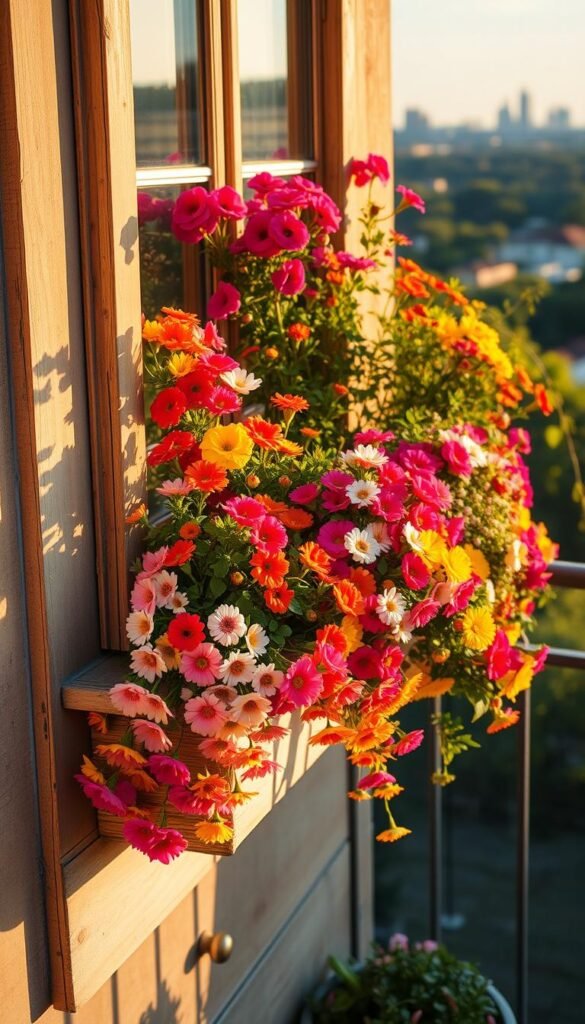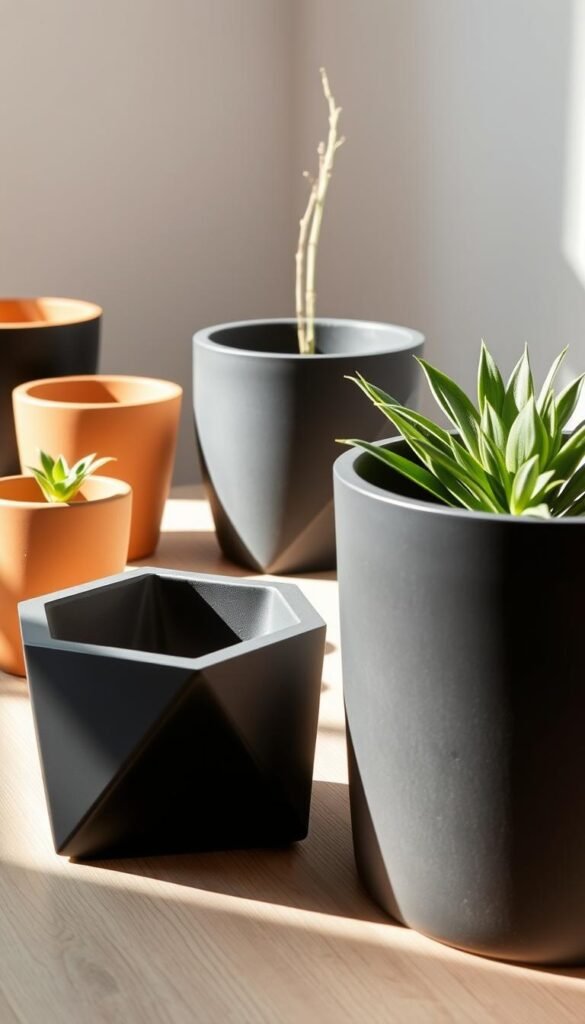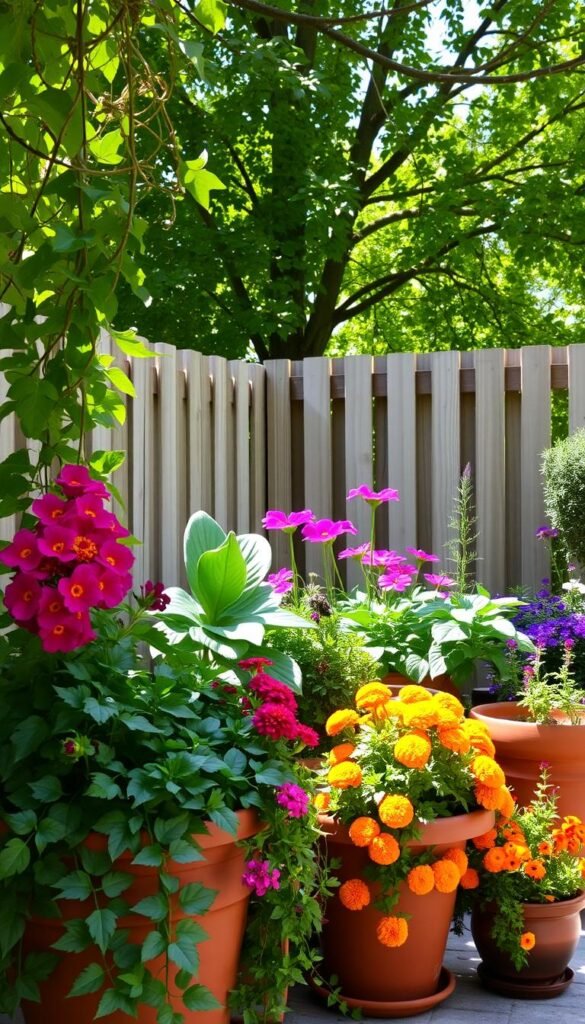Small outdoor areas don’t have to limit your green thumb. With creative potted arrangements, even compact spaces like railings or paved surfaces can burst with life. These movable planters let you design lush displays that thrive in limited sunlight or tight corners.
Seasonal changes? No problem. You can shift your setup to catch morning rays or shelter delicate blooms during storms. Mix textures and heights for visual drama—think trailing vines beside upright grasses. For inspiration, explore vibrant blooms that adapt to your unique environment.
New to gardening? Start simple with hardy annuals in classic clay pots. Experienced growers might layer perennials for year-round interest. Either way, your setup evolves as you learn—swap plants, rearrange groupings, or introduce bold hues for instant curb appeal.
From urban ledges to suburban decks, these portable ecosystems turn overlooked nooks into lively retreats. They’re practical, personal, and proof that nature thrives wherever you make space for it.
Inspiring Benefits of Container Flower Gardens
Transforming overlooked corners into vibrant displays brings surprising advantages. These living arrangements let you reimagine how you use every inch of your home’s exterior while delivering instant curb appeal.
Enhancing Outdoor Spaces
Vertical layers in containers turn blank walls into living art. Tall planters with climbing vines draw attention upward, making narrow areas feel spacious. Pair cascading greenery with bold flowers for depth that captivates.
Strategic placement creates inviting zones. A trio of hydrangeas in large pots marks entryways with soft pinks and blues. Smaller groupings near seating areas foster cozy atmospheres perfect for morning coffee.
Balancing Functionality and Aesthetics
Dense foliage screens unsightly AC units while releasing soothing scents. Herbs like lavender add fragrance near windows, blending beauty with purpose. Textured leaves soften concrete surfaces without permanent changes.
Rotate color schemes monthly for fresh energy. Swap summer zinnias for autumn mums using the same vessels. This flexibility keeps your space evolving with minimal effort—no landscaping required.
Your creativity becomes the ultimate inspiration. Neighbors might copy your cascading petunia display, but your unique combinations will always stand out.
Planning Your Container Garden for Patios and Balconies

Crafting a lush retreat begins with understanding your unique environment. Start by mapping your area’s dimensions and noting permanent features like railings or built-in benches. This groundwork helps avoid overcrowding and ensures every plant has room to shine.
Assessing Your Space and Sunlight
Track light patterns for three days straight. Morning rays suit ferns, while afternoon sun demands drought-tolerant varieties. Shady corners? They’re perfect for coleus or coral bells. Remember—seasons change light availability, so plan for shifting conditions.
Check weight limits if you’re gardening upstairs. Lightweight fiberglass pots prevent structural stress. Ensure easy water access—lugging watering cans gets old fast. Windy spots need sturdy bases or wall-mounted options to prevent tumbles.
Budgeting and Container Selection
Prioritize durable materials over trendy designs. Self-watering pots save time, while terracotta breathes better for root health. Mix sizes for visual interest—tall planters anchor spaces, while shallow bowls showcase succulents.
Allocate funds for premium soil—it’s the foundation of thriving plants. For practical tips for outdoor living, consider how your color palette complements nearby furniture. Rotate seasonal stars like pansies or ornamental kale to keep costs manageable year-round.
Container Flower Garden Ideas: Brightening Patios and Balconies

Unlock the visual potential of your space by mastering color dynamics and foliage variety. Thoughtful combinations turn simple arrangements into living masterpieces that captivate year-round.
Using Color to Create Impact
Complementary hues—like purple and yellow—create electric contrasts in tight spaces. For calm cohesion, try analogous tones: coral begonias paired with peach geraniums. Light-colored blooms placed near seating areas make zones feel airy, while deep burgundy leaves in back add mystery.
Mixing Textures and Foliage
Combine spiky dracaena with velvety lamb’s ear for tactile drama. Coleus steals the show with its rainbow leaves, needing no flowers to make big impact. Japanese painted ferns add lace-like delicacy beside rubbery sweet potato vines.
Architectural plants like yucca anchor designs, while trailing ivy softens edges. This balance keeps arrangements lively even between bloom cycles. For foolproof pairings, explore curated plant combinations that thrive together.
Test your palette at different times—morning light intensifies pastels, while sunset highlights metallic foliage. Your container plants become chameleons, shifting moods with the sun’s angle.
Choosing the Right Container Plants and Potting Soil

Your living arrangements thrive when you match greenery with their ideal growing environment. Smart selections ensure vibrant growth while minimizing maintenance—even in tight quarters.
Essential Plant Characteristics
Look for varieties that naturally adapt to confined roots. Dwarf varieties of herbs and shrubs outperform their full-sized cousins in limited spaces. Prioritize these traits:
| Trait | Why It Matters | Examples |
|---|---|---|
| Compact growth | Prevents overcrowding | Miniature roses, dwarf citrus |
| Drought tolerance | Reduces watering needs | Sedum, lavender |
| Shallow roots | Thrives in 8-12″ depth | Pansies, lettuce |
Tips for Selecting Quality Potting Soil
Premium blends make all the difference for root health. Avoid dense garden dirt—it suffocates roots and holds too much moisture. The ideal mix feels light yet retains nutrients.
Look for these ingredients when comparing bags:
- Peat moss/coconut coir: Holds moisture without sogginess
- Perlite: Creates air pockets for oxygen flow
- Worm castings: Slow-release nutrition
Refresh your medium every spring. Compacted soil loses drainage capacity, starving roots of oxygen. Mix in granular fertilizer during replanting for season-long feeding.
Creative Container Options for Small Spaces

Maximizing vertical surfaces unlocks new possibilities for plant lovers. Window boxes transform narrow ledges into blooming showcases, while cleverly designed vessels turn cramped corners into lush retreats. Your limited square footage becomes an advantage when you think upward and outward.
Window Boxes and Compact Planters
Rail-mounted planters let you grow herbs or trailing petunias without sacrificing floor space. Repurposed items like galvanized buckets or antique toolboxes add personality while housing succulents or dwarf marigolds. The key? Matching plant size to vessel depth—shallow roots thrive in 6-8″ soil.
Consider these space-smart solutions:
| Container Type | Best Use | Plant Examples |
|---|---|---|
| Window boxes | Sunny ledges | Geraniums, thyme, ivy |
| Repurposed crates | Rustic accents | Strawberries, pansies |
| Stackable planters | Vertical gardens | Lettuce, alyssum |
Mix textures for year-round appeal—silver dichondra pairs beautifully with purple lobelia. For those starting out, our beginner’s guide to container gardening simplifies plant selection and care.
Rotate seasonal stars every few months to keep displays fresh. A spring arrangement of snapdragons can shift to autumn chrysanthemums using the same box. This flexibility lets you experiment with color schemes without replanting entire beds.
Designing with Classic Clay Pots and Modern Planters

Blending timeless materials with sleek designs creates outdoor magic. Classic terracotta offers natural charm, while modern vessels bring bold shapes. Together, they form dynamic duos that elevate your garden design.
Combining Old-School Clay with Contemporary Styles
Terracotta’s porous nature helps roots breathe—perfect for moisture-sensitive herbs like rosemary. Pair these earthy pots with glossy fiberglass planters for striking contrast. A cluster of clay vessels beside a geometric metal trough adds depth without clashing.
Mix sizes for layered appeal. Place petite succulents in miniature terracotta cups near tall, minimalist towers. This balance lets each piece shine while creating cohesive groupings.
Utilizing Colorful Frontgate and Front Step Planters
Frontgate’s Versailles collection brings Parisian elegance to your doorstep. Their neutral tones let vibrant blooms take center stage. For pops of color, try cobalt-blue resin planters flanking your entry path.
Pro tip: Use matching pots on stair risers to guide the eye upward. Swap seasonal flowers while keeping the same vessels—spring pansies transition effortlessly to fall ornamental kale. Your look stays fresh with minimal effort.
Tips for Mixing Flowers, Foliage, and Seasonal Elements
Elevate your arrangements by blending showstoppers with subtle accents. The secret lies in balancing bold colors with textural contrasts that shift with the seasons. Let’s explore how to layer plants for maximum visual punch.
Three-Star Performers for Dynamic Displays
Hydrangeas form lush backdrops in shaded corners, their mophead blooms lasting weeks. Pair them with rex begonias—their metallic leaves add shimmer without competing for attention. Let sweet potato vine spill over edges, its heart-shaped foliage softening planter lines.
Rotate seasonal accents around these anchors. In fall, tuck ornamental kale between hydrangea stems. Come winter, red twig dogwood branches add structure. This approach keeps your display evolving while maintaining core foliage interest.
Pro tip: Use trailing sweet potato vine to disguise leggy stems on taller plants. Its vigorous growth fills gaps quickly, creating seamless transitions between flowers and filler greens. For more design recipes, study how professionals layer rex begonias with contrasting textures.






